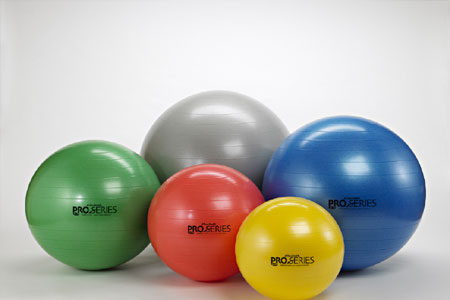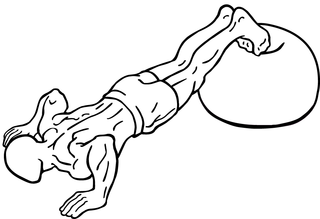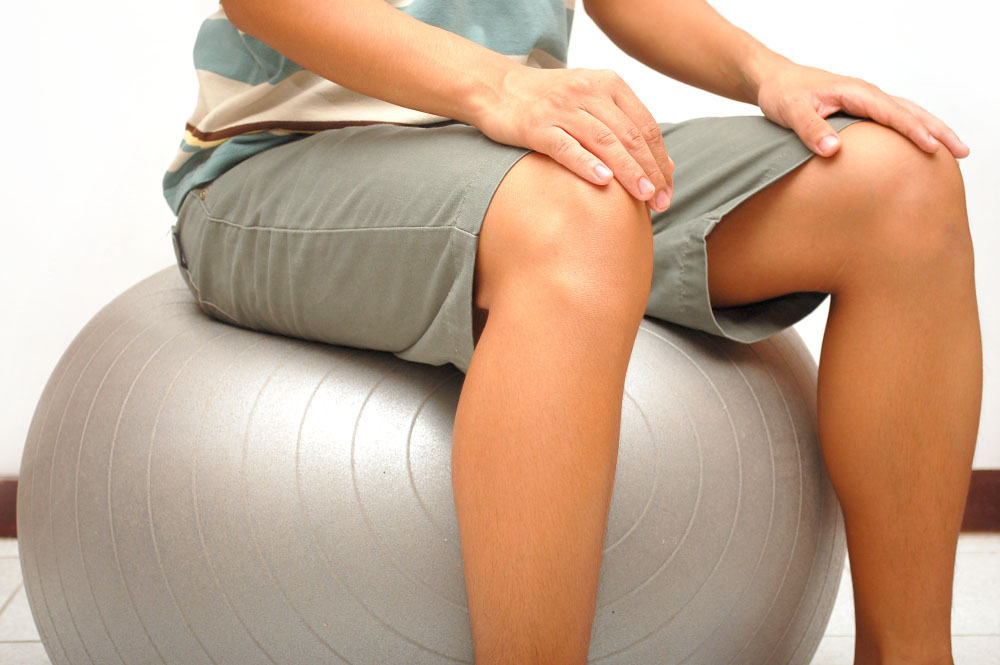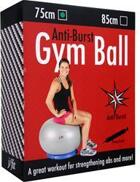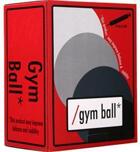Exercise balls -- also called stability balls, Swiss balls, and physioballs -- were first used as a therapeutic tool in Switzerland and have been a staple at fitness facilities since the late 1980s. Exercise balls, not too be confused with weighted medicine balls, are reasonably priced and used to perform a variety of exercises and stretches.
Selecting an exercise ball
Exercise balls come in a variety of sizes. Experts suggest selecting a ball that does not interfere with your posture. When sitting on an exercise ball, you should be able to sit up straight with shoulders back, knees and hips at a 90-degree angle, and feet flat on the floor.
Sizing chart
Use this stability ball sizeing guide when considering your purchase:
- 4'10" and under: 30cm to 35cm
- 4'8" to 5'5": 45cm
- 5'6" to 6'0": 55cm
- 6'0" to 6'5": 65cm
- 6'5" and taller: 75cm
- For heavier and taller exercises, there's an 85cm ball
If you're doing range-of-motion moves or working on balance techniques, your size -- height and weight -- and exercise experience does not have to influence the type of ball you use. But be sure to discuss any changes to your physical activity routine with a healthcare provider or licensed physical fitness professional.
Uses
Exercise balls can help strengthen your core muscles and improve range of motion, balance, posture, and flexibility. Exercise balls are used for physical rehabilitation, in sports and endurance training as well.
Types of exercises
You can use a physioball to strengthen your core abs (upper and lower obliques), chest muscles (upper, lower, inner, and outer pectorals), shoulders (inner, outer, and rear deltoids), back (upper and lower lats, lower back and trapezius), legs (hamstrings, quadriceps, inner thighs, hips and calves), arms (biceps, triceps, inner and outer forearms).
Abdominal muscles
One popular routine is the crunch. Place a small exercise ball against a wall behind your lower back. Keep your posture straight, with shoulder and hips aligned and abdominal muscles sturdy. Methodically lower yourself down toward the floor while keeping the ball in place. Once your thighs are parallel to the floor and your legs are at a 90-degree angle, slowly return to the starting position.
Be sure to squat and stand using your leg muscles rather than your knees. Your should feel a burn in your abs and legs. For balance, extend your arms either straight out in front of your body (parallel to the floor), or out to your sides.
Chest muscles
This move resembles an ordinary pushup, but instead of placing your hands flat on the floor, place them and push up off your physioball. This move helps build and tone arm muscles, but also challenges your balance.
Can't handle pushups? Start with your knees on the floor. Be sure your back is fully extended.
For more of a challenge, balance your thighs on the ball while you push up off the floor, like a traditional pushup. This move will also strengthen ab muscles.
Shoulder muscles
This move requires you to use hand weights. Be sure to choose weights that challenge your muscles, but won't wear you out.
Lie your belly on the exercise ball with legs extended behind you, toes on the floor and heels pointing up at the ceiling. Hold dumbbells just a few inches off the floor. Your hands should be parallel with your shoulders. Slowly lift both arms simultaneously until dumbbells are about shoulder height and elbows form a 90-degree angle. Hold for a short pause and return to starting position.
Back muscles
With your feet flat on the floor, rest your head, neck, and shoulders on your exercise ball. Cross arms across your chest. Start with your butt near the floor. Using your back and ab muscles, lift your buttocks up toward the ceiling until your legs form a 90-degree angle. Hold pose for a few seconds, return to starting position, and repeat.
Leg muscles
The leg curl requires you to lay flat on your back with your legs on the exercise ball forming a 90-degree angle. Pull your feet toward your buttocks, pulling the ball toward the back of your thighs. Repeat several times. Done correctly, you should feel the burn throughout your calves.
Other uses
Exercise ball chairs are popping up in offices and classrooms to help improve posture. They function as a device that forces proper posture and results in fewer aches and pains. Does it work? According to a New York Times blog post, spine and injury expert, Jack P. Callaghan, PhD., from the University of Waterloo in Ontario, does not see an advantage.[5] As part of a small study, Professor Callaghan and colleagues had volunteers sit in a traditional office chair or on a stability ball for one hour while performing ordinary business tasks. The researchers found that sitting on the ball did not significantly alter the manner in how an individual typically sits. They also found that volunteers experienced increased discomfort.[6]
Considerations
A strong core (abdominal, back, and hip flexor/extensor muscles) is important for all movement and activity, especially when you incorporate dumbbells. Your exercise ball can help you achieve these goals.While a stability ball may not improve posture or reduce aches and pains, there's no question that taking work break and using physioball to stretch out your arms, legs, neck, shoulders back can help fight fatigue and prevent muscle soreness.
You can stash exercise ball in a closet, under a table, above a filing cabinet, in a break room, and numerous other places.
Safety tips
- Always check with your doctor before you start a new exercise program, especially if you're typically sedentary or haven't had a medical checkup in more than a year. It's a good idea to seek the advice and instruction of a personal trainer or exercise specialist on how to effectively and safely use any new workout device, including an exercise ball.
- Like with any type of workout, stop exercising immediately if you experience chest pain, difficulty breathing, or dizziness. Seek medical attention.
- Do not use a physioball if you have a condition where you suddenly lose balance for no apparent reason. Sudden blood pressure changes can do this.
- Read the instructions that come with your exercise ball. Any good workout equipment will provide useful product suggestions. For an exercise ball, that should include inflation instruction. A ball with too much air can be difficult to balance on. A ball that is under inflated will not be as effective in the exercises mentioned here.
- As with any inflatable device, watch for sharp objects that might cause a puncture.
Stretches
There's no bad time to stretch. An exercise ball is the perfect device for preventing spasms and tight muscles. Here are just two stretches you can try:
Mobility stretch
Sit on your ball with your shoulders back, hips, and shoulders in alignment and tightened abs. Walk your legs forward and slightly roll down to the point where the ball is at the center of your back. Walk back to starting position. Be sure to breathe deeply in and out during this move and keep abs tight.
There are several other stretches you can do at home, at the office, or gym. Talk to your fitness professional or go to a site like Spine-Health.com for more suggestions.[7]
Extensions
Lie face down with your belly and chest on the ball and legs extended behind you, toes on the floor. Dangle your arms loosely along side the exercise ball, resting on the floor. Using your lower back muscles, raise your back, neck, and head toward the ceiling. Do not lead with your neck and head. Once you feel the stretch in your spine, hold the post for several moments then relax and repeat.
Where to buy
Although we don't sell exercise balls, you can compare different brands, quality, and prices here at PricePlow. Please note that we are not medical professionals. Never mistake our reporting for healthcare advice. Always talk to your physician before starting a new exercise routine, take vitamins or supplements.
References
- American College of Sports Medicine "ACSM Information On Selecting and Effectively Using a Stability Ball"
- Ball-Exercises.com; "Complete List of Ball Exercises"
- HeatherHatfield; WebMD.com; "Having a 'Ball' With Exercise"
- American Council on Exercise; Fit Facts; "Strengthen Your Abdominals With Stability Balls"
- Gretchen Reynolds; The New York Times Health and Sciences; "Ask Well: Do Ball Chairs Offer Benefits?" 2013
- Gregory DE, Callaghan JP,; Human Factors; "Stability ball versus office chair: comparison of muscle activation and lumbar spine posture during prolonged sitting;" 2006
- Thomas E. Hyde, DC; Spine-Health.com; "Commonly Prescribed Exercise Ball Workouts for Back Pain;" Updated 2010
Exercise Ball Price Alerts
The following price alerts are still active:
- Aug 17, 2025J-FIT Gym Ball with Pump 1 Ball dropped by 7.8% to $14.75 at AllStarHealth
Sign up for future Exercise Ball deals and coupons!
Click the button below to sign up for future Exercise Ball deals, news, and coupons!
